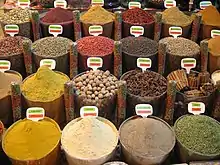
A spice market in Istanbul

Night spice market in Casablanca.
This is a list of culinary herbs, spices, and blends. Specifically these are food or drink additives of mostly botanical origin used in nutritionally insignificant quantities for flavoring or coloring.
This list does not contain fictional plants such as aglaophotis, or recreational drugs such as tobacco.
This list is not for plants used primarily for herbal teas, nor for purely medicinal plant products, such as valerian.
A
- Ajwain, carom seeds (Trachyspermum ammi) (Pakistan, South Asia, India, Afghanistan, Iran, Egypt, Eritrea & Ethiopia)
- Alexanders (Smyrnium olusatrum)
- Alkanet (Alkanna tinctoria), for red color
- Alligator pepper, mbongo spice (mbongochobi), hepper pepper (Aframomum danielli, A. citratum, A. exscapum) (West Africa)
- Allspice (Pimenta dioica)
- Angelica (Angelica archangelica)
- Anise (Pimpinella anisum)
- Aniseed myrtle (Syzygium anisatum) (Australia)
- Annatto (Bixa orellana)
- Artemisia (Artemisia spp.)
- Asafoetida (Ferula assafoetida)
- Avens (Geum urbanum)
- Avocado leaf (Persea americana)
B
- Barberry (Berberis vulgaris and other Berberis spp.)
- Basil, sweet (Ocimum basilicum)
- Basil, Holy (Ocimum tenuiflorum)
- Basil, lemon (Ocimum × citriodorum)
- Basil, Thai (O. basilicum var. thyrsiflora)
- Bay leaf (Laurus nobilis)
- Bay leaf, Indian; tejpat, malabathrum (Cinnamomum tamala)
- Bay leaf, Indonesian; Indonesian laurel, Salam leaf, daun salam (Syzygium polyanthum)
- Bay leaf, Mexican; laurél (Litsea glaucescens)
- Bay leaf, West Indian (Pimenta racemosa)
- Blue fenugreek, blue melilot (Trigonella caerulea)
- Boldo (Peumus boldus)
- Borage (Borago officinalis)
C
- California bay laurel (Umbellularia californica)
- Cao guo, Chinese black cardamom (Lanxangia tsaoko) (China)
- Caper (Capparis spinosa)
- Caraway (Carum carvi)
- Cardamom (Elettaria cardamomum)
- Cardamom, black; badi ilaichi (Amomum subulatum, Amomum costatum) (India, Pakistan)
- Cassia (Cinnamomum aromaticum)
- Cayenne pepper (Capsicum annuum)
- Celery leaf (Apium graveolens)
- Celery seed (Apium graveolens)
- Chervil (Anthriscus cerefolium)
- Chicory (Cichorium intybus)
- Chili pepper (Capsicum spp.)
- Chironji, charoli (Buchanania lanzan)
- Chives (Allium schoenoprasum)
- Cicely, sweet cicely (Myrrhis odorata)
- Cilantro, coriander greens, coriander herb, Chinese parsley (Coriandrum sativum)
- Cinnamon, Indonesian (Cinnamomum burmannii, Cassia vera)
- Cinnamon, Saigon or Vietnamese (Cinnamomum loureiroi)
- Cinnamon, true or Ceylon (Cinnamomum verum, C. zeylanicum)
- Cinnamon, white (Canella winterana)
- Cinnamon myrtle (Backhousia myrtifolia) (Australia)
- Clary, Clary sage (Salvia sclarea)
- Clove (Syzygium aromaticum)
- Coriander seed (Coriandrum sativum)
- Coriander, Vietnamese (Persicaria odorata)
- Costmary (Tanacetum balsamita)
- Cubeb pepper (Piper cubeba)
- Culantro, culangot, long coriander, recao (Eryngium foetidum)
- Cumin (Cuminum cyminum)
- Curry leaf (Murraya koenigii)
- Curry plant (Helichrysum italicum)
- Cyperus articulatus
D
E
- Elderflower (Sambucus spp.)
- Epazote (Dysphania ambrosioides)
F
- Fennel (Foeniculum vulgare)
- Fenugreek (Trigonella foenum-graecum)
- Fenugreek, Blue, blue melilot (Trigonella caerulea)
- Filé powder, gumbo filé (Sassafras albidum)
- Fingerroot, temu kuntji, krachai, k'cheay (Boesenbergia rotunda) (Java, Thailand, Cambodia)
- Fish mint, leaf; giấp cá (Houttuynia cordata) (Vietnam)
- Fish mint, rhizome; zhé ěrgēn (Houttuynia cordata) (Guizhou, Sichuan, Yunnan, and Guangxi provinces of China)
G
- Galangal, greater (Alpinia galanga)
- Galangal, lesser (Alpinia officinarum)
- Garlic (Allium sativum)
- Garlic chives (Allium tuberosum)
- Ginger (Zingiber officinale)
- Ginger, torch; bunga siantan (Etlingera elatior) (Indonesia)
- Golpar, Persian hogweed (Heracleum persicum) (Iran)
- Grains of paradise (Aframomum melegueta)
- Grains of Selim, Kani pepper (Xylopia aethiopica)
H
- Hoja santa, hierba santa, acuyo (Piper auritum) (Mexico)
- Horseradish (Armoracia rusticana)
- Huacatay, Mexican marigold, mint marigold (Tagetes minuta)
- Hyssop (Hyssopus officinalis)
J
- Jasmine flowers (Jasminum spp.)
- Jakhya (Cleome viscosa)
- Jalapeño (Capsicum annuum cultivar)
- Jimbu (Allium hypsistum) (Nepal)
- Juniper berry (Juniperus communis)
K
- Kaffir lime leaves, Makrud lime leaves (Citrus hystrix) (Southeast Asia)
- Kala zeera, kala jira, black cumin (Bunium persicum) (South Asia)
- Keluak, kluwak, kepayang (Pangium edule)
- Kencur, galangal, kentjur (Kaempferia galanga) (Java, Bali)
- Kinh gioi, Vietnamese balm (Elsholtzia ciliata)
- Kokam seed (Garcinia indica) (Indian confectionery)\
- Kokum (rind of G. indica fruit), a souring agent (India)
- Korarima, Ethiopian cardamom, false cardamom (Aframomum corrorima) (Eritrea)
- Koseret leaves (Lippia abyssinica) (Ethiopia)
- Kudum Puli (Garcinia gummi-gutta)
- Kutjura (Solanum centrale) (Australia)
L
- Lavender (Lavandula spp.)
- Lemon balm (Melissa officinalis)
- Lemon ironbark (Eucalyptus staigeriana) (Australia)
- Lemon myrtle (Backhousia citriodora) (Australia)
- Lemon verbena (Lippia citriodora)
- Lemongrass (Cymbopogon citratus, C. flexuosus, and other Cymbopogon spp.)
- Leptotes bicolor (Paraguay and southern Brazil)
- Lesser calamint (Calamintha nepeta), nipitella, nepitella (Italy)
- Licorice, liquorice (Glycyrrhiza glabra)
- Lovage leaves (Levisticum officinale)
- Lovage seeds (Levisticum officinale)
- Locust beans (Ceratonia siliqua)
M
- Mace (Myristica fragrans)
- Mahleb, mahalepi, St. Lucie cherry (Prunus mahaleb)
- Marjoram (Origanum majorana)
- Mastic (Pistacia lentiscus)
- Mint (Mentha spp.), 25 species, hundreds of varieties
- Mountain horopito (Pseudowintera colorata), 'pepper-plant' (New Zealand)
- Musk mallow, abelmosk (Abelmoschus moschatus)
- Mustard, black, mustard plant, mustard seed (Brassica nigra)
- Mustard, brown, mustard plant, mustard seed (Brassica juncea)
- Mustard, white, mustard plant, mustard seed (Sinapis alba)
- Mustard, yellow (Brassica hirta = Sinapis alba)
N
- New Mexico chile (Capsicum annuum 'New Mexico Group', also known as Hatch or Anaheim) which includes Big Jim, Chimayó, and Sandia, and other pepper cultivars.
- Nigella, black caraway, black cumin, black onion seed, kalonji (Nigella sativa)
- Njangsa, djansang (Ricinodendron heudelotii) (West Africa)
- Nutmeg (Myristica fragrans)
O
- Olida (Eucalyptus olida) (Australia)
- Oregano (Origanum vulgare, O. heracleoticum, and other species)
- Oregano, Cuban (Coleus amboinicus)
- Oregano, Greek, Turkish oregano (Origanum vulgare var. hirtum)
- Oregano, Mexican (Lippia graveolens)
- Orris root (Iris germanica, I. florentina, I. pallida)
P
- Pandan flower, kewra (Pandanus odoratissimus)
- Pandan leaf, screwpine (Pandanus amaryllifolius)
- Pápalo (Porophyllum ruderale) (Mexico and South America)
- Paprika (Capsicum annuum)
- Paracress (Acmella oleracea) (Brazil)
- Parsley (Petroselinum crispum)
- Passion berry, Tena adam (Amharic) (Ruta chalepensis)
- Pennyroyal (Mentha pulegium)
- Pepper, black, white, and green (Piper nigrum)
- Pepper, Brazilian, or pink pepper (Schinus terebinthifolius)
- Pepper, Dorrigo (Tasmannia stipitata) (Australia)
- Pepper, long (Piper longum)
- Pepper, mountain, Cornish pepper leaf (Tasmannia lanceolata)
- Peppermint (Mentha piperata)
- Peppermint gum leaf (Eucalyptus dives)
- Perilla (Mentha pulegium)
- Peruvian pepper (Schinus molle)
- Pipicha, straight-leaf pápalo (Porophyllum linaria) (Mexico)
- Poppy seed (Papaver somniferum)
- Purslane
Q
- Quassia (Quassia amara), bitter spice in aperitifs and some beers and fortified wines
R
- Red rice powder (Monascus purpureus) (China)
- Rice paddy herb (Limnophila aromatica) (Vietnam)
- Rosemary (Rosmarinus officinalis)
- Rue (Ruta graveolens)
S
- Safflower (Carthamus tinctorius), only for yellow color
- Saffron (Crocus sativus)
- Sage (Salvia officinalis)
- Salad burnet (Sanguisorba minor)
- Sassafras (Sassafras albidum)
- Sesame Seed, Black Sesame Seed
- Savory, summer (Satureja hortensis)
- Savory, winter (Satureja montana)
- Shiso (Perilla frutescens)
- Sichuan pepper (Zanthoxylum piperitum)
- Silphium, silphion, laser, laserpicium, sorado (Ancient Roman cuisine, Ancient Greek cuisine)
- Sorrel (Rumex acetosa)
- Sorrel, sheep (Rumex acetosella)
- Spearmint (Mentha spicata)
- Spikenard (Nardostachys grandiflora or N. jatamansi)
- Star anise (Illicium verum)
- Stone parsley (Sison amomum)[1][2][3]
- Sumac (Rhus coriaria)
- Sweet woodruff (Galium odoratum)
T
- Tajin
- Tarragon (Artemisia dracunculus)
- Tasmanian pepper (Tasmannia lanceolata)
- Thyme (Thymus vulgaris)
- Thyme, lemon (Thymus citriodorus)
- Tonka beans (Dipteryx odorata)
- Turmeric (Curcuma longa)
V
- Vanilla (Vanilla planifolia)
- Voatsiperifery (Piper borbonense) [Madagascar]
W
- Wasabi (Wasabia japonica)
- Water-pepper, smartweed (Polygonum hydropiper)
- Wattleseed (from about 120 spp. of Australian Acacia)
- Wild thyme (Thymus serpyllum)
- Wintergreen (Gaultheria procumbens)
- Wood avens, herb bennet (Geum urbanum)
- Woodruff (Galium odoratum)
- Wormwood, absinthe (Artemisia absinthium)
Y
- Yerba buena, any of four different species, many unrelated
- Yarrow (Achillea millefolium)
Z
See also
Wikibooks Cookbook has a recipe/module on
Culinary herbs and spices by country, region and culture
- List of Afghani spices and herbs
- Assamese spices
- Aztec spices
- Bulgarian spices
- Chilean herbs and spices
- Hungarian spices
- Indonesian spices
- List of Armenian spices and herbs
- List of Australian herbs and spices
- List of Bangladeshi spices
- List of Gujarati spices
- List of Indian spices
- List of Indonesian spices (bumbu)
- List of Indonesian spices
- List of Italian herbs and spices
- List of Pakistani spices
- List of Puerto Rican spices and seasonings
- List of Thai herbs and spices
- List of Vietnamese spices and herbs (Vietnamese ingredients)
- Lithuanian spices
- Manado spices
- Medieval spices
- Moroccan spices
- Nigerien spices
- Sri Lankan spices
- South Asian spices
- Thai herbs and spices
- Vietnamese herbs and spices
References
- ↑ "stone parsley". Merriam-Webster, Inc. 2023-03-16.
stone parsley, noun, 1, : a slender herb (Sison amomum) of the family Umbelliferae that is native to Europe and Asia Minor and has aromatic seeds which are used as a condiment. 2, : any plant of the genus Seseli
- ↑ von Mueller, Ferdinand (1891). Select extra-tropical plants readily eligible for industrial culture or naturalisation (8th ed., rev. and enl. ed.). Melbourne, Australia: C. Troedel and Co. p. 458. Archived from the original on 2023-04-23. Retrieved 2023-04-27.
Sison Amomum, Linné. Middle and Southern Europe. An herb of one or two years' duration. It grows on soil rich with lime. The seeds can be used as condiment.
{{cite book}}: CS1 maint: bot: original URL status unknown (link) - ↑ Harford, Robin (2023-03-16). "40 Wild Edible Plants in the Carrot Family". www.eatweeds.co.uk. Robin Harford. Retrieved 2023-03-16.
Stone Parsley: Sison amomum ABUNDANT – Parts used: Leaves, seed, root
This article is issued from Wikipedia. The text is licensed under Creative Commons - Attribution - Sharealike. Additional terms may apply for the media files.